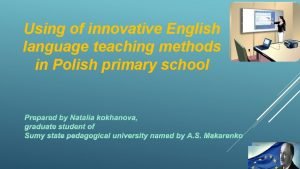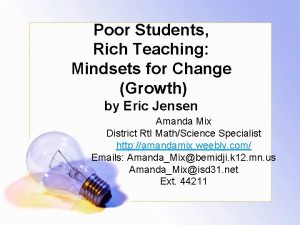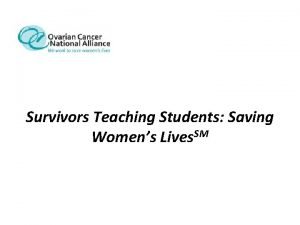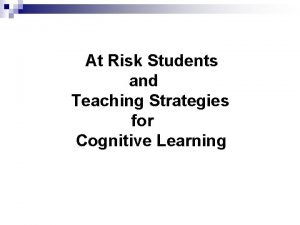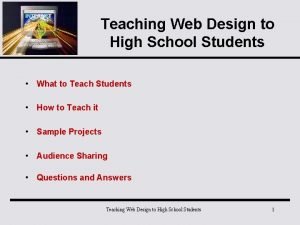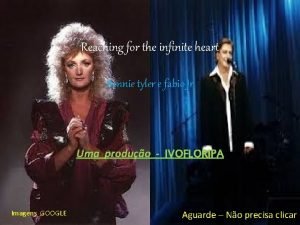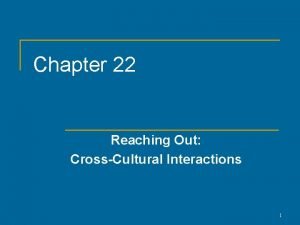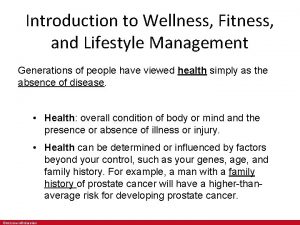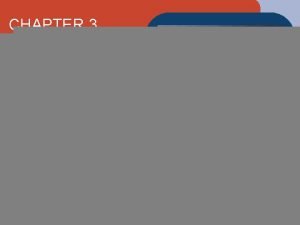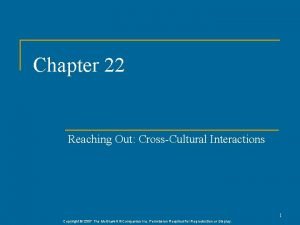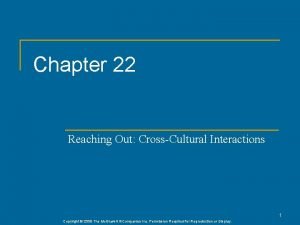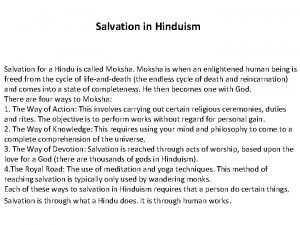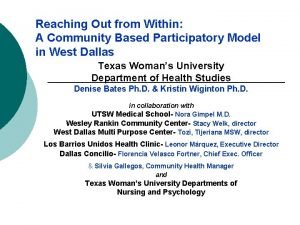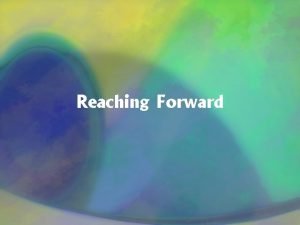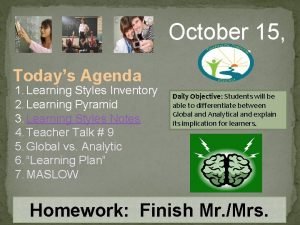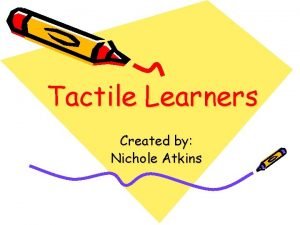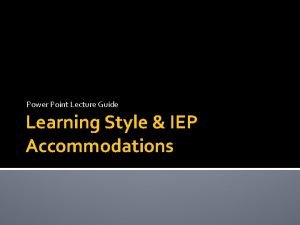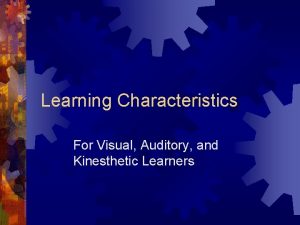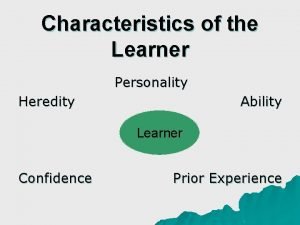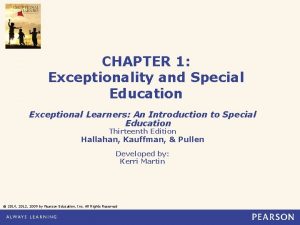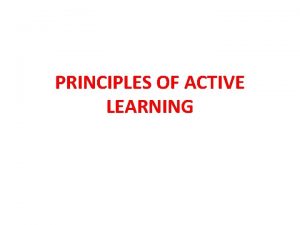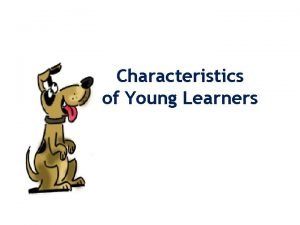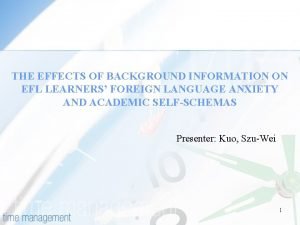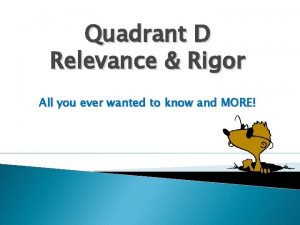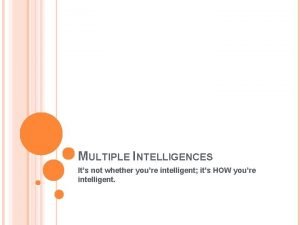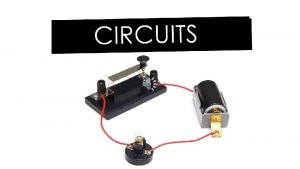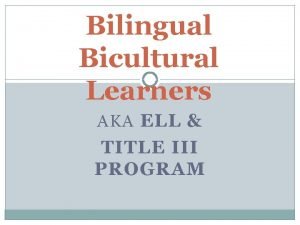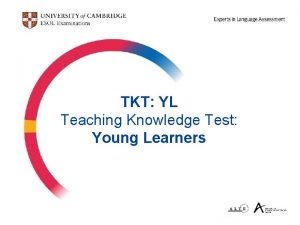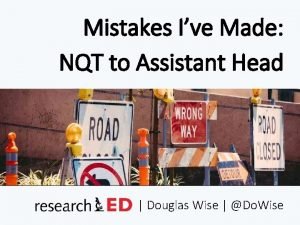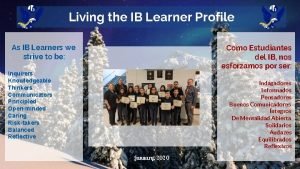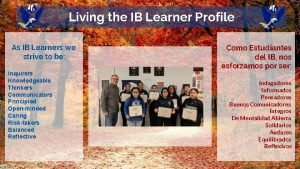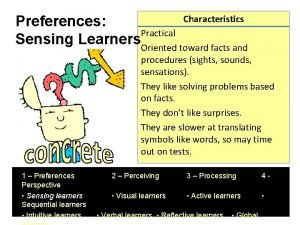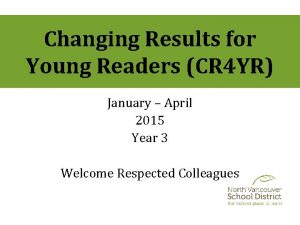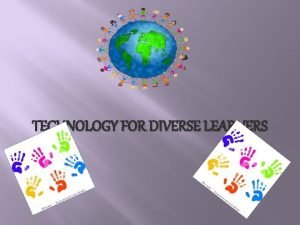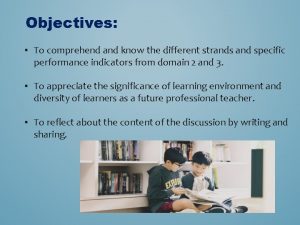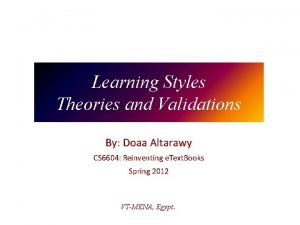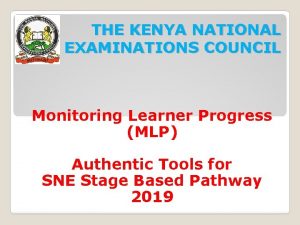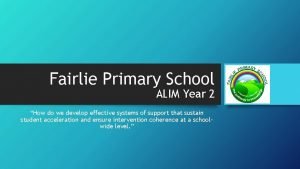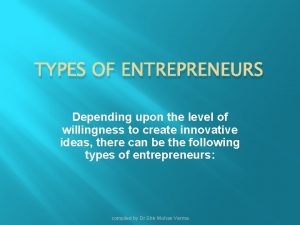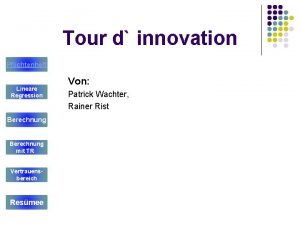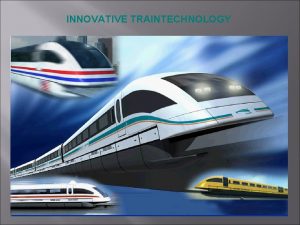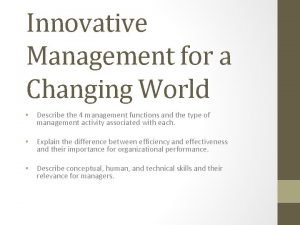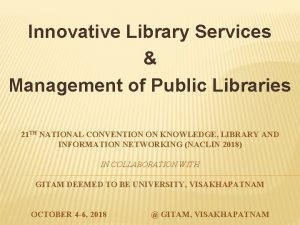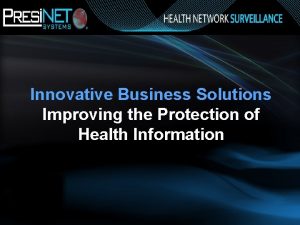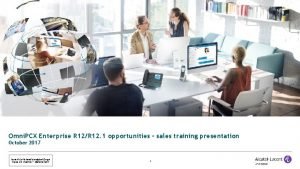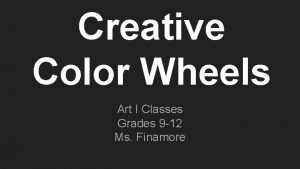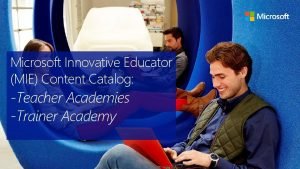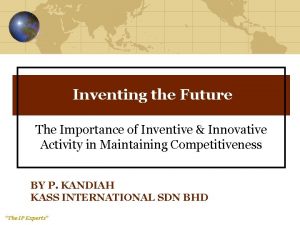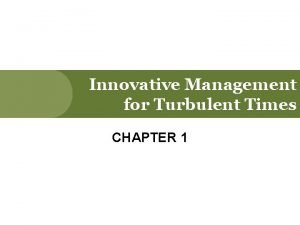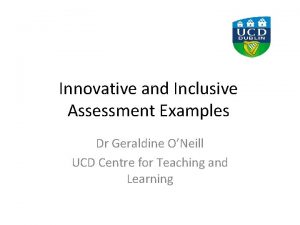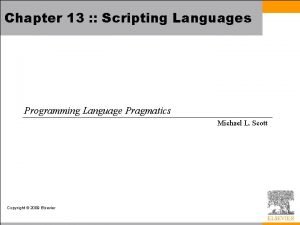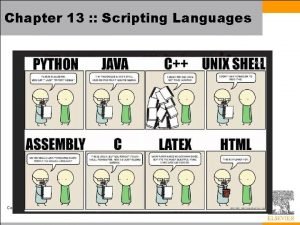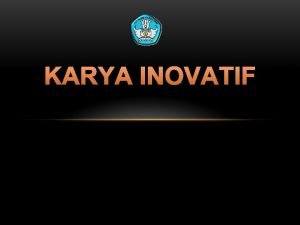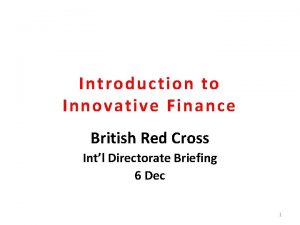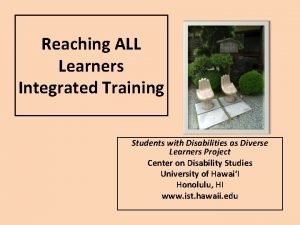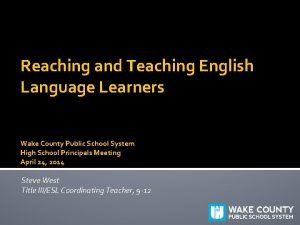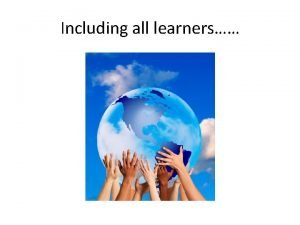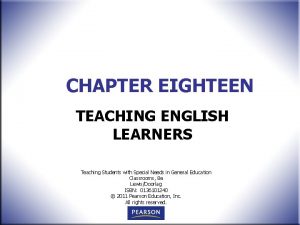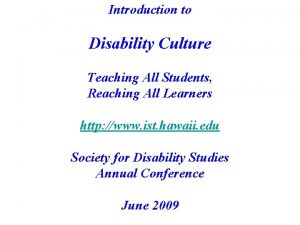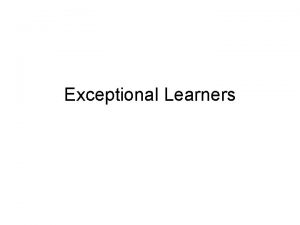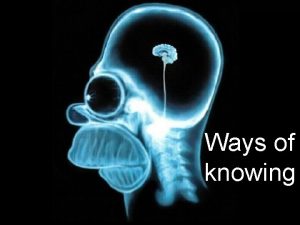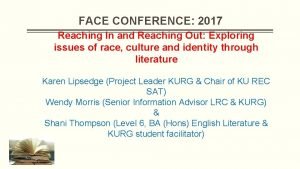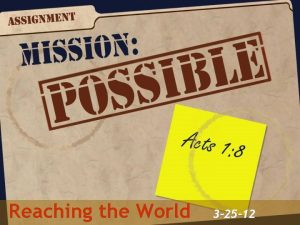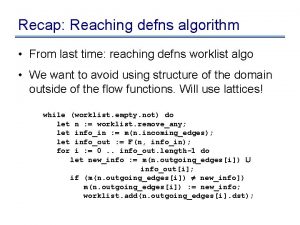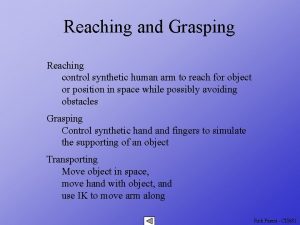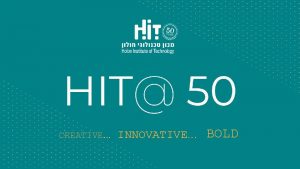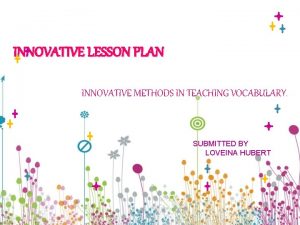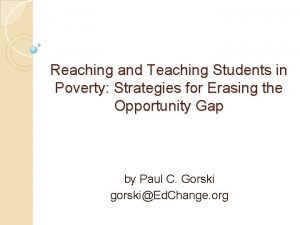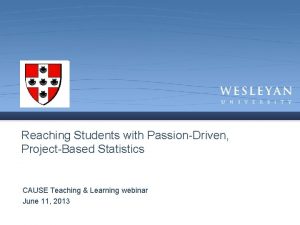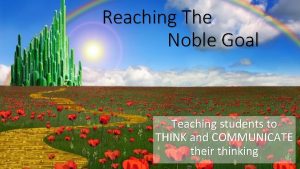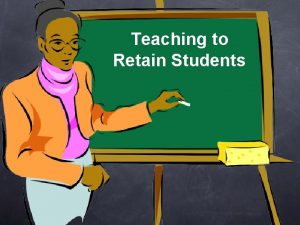Teaching All Students Reaching All Learners Innovative Ways












































































- Slides: 76

Teaching All Students, Reaching All Learners: Innovative Ways to Address Disability and Diversity in the Postsecondary Classroom A Presentation prepared for the 2006 Pac Rim Conference by Katharina Heyer, Steve Brown, Kelly Chang Center on Disability Studies University of Hawai’i

OPE Grant • US DOE Office for Postsecondary Education • 3 years • UH Manoa, then Community Colleges, West O’ahu, UH Hilo • CBI Capacity Building Institute w Thursday March 16 w Email velina@hawaii. edu

Three Aspects • Professional Development w Katharina Heyer, Assistant Professor in Political Science, Law, and Disability Studies (CDS) • Assistive Technology w Steve Brown, Assistant Professor of Disability Studies (CDS) • Mentoring w Kelly Chang, Ph. D Candidate in Psychology

What we know about Faculty Attitudes & Knowledge • Survey of faculty attitudes and practices • Two-thirds of faculty have limited contacts with students with disabilities • Large majority had little or no experience teaching students with disabilities • Those with experience had it with students with LD and students with visual, hearing, or orthopaedic impairments • Least experience with psychiatric disabilities and chronic illness Leyser, Y. , Vogel, S. , Wyland, S. , and Brulle, A. (1998). Faculty Attitudes and Practices Regarding Students with Disabilities: Two Decades after Implementation of Section 504. Journal on Postsecondary Education and Disability

What we know about Faculty Attitudes & Knowledge • Surveys of students assessing faculty knowledge of disability issues and accommodations • Faculty were evaluated on the low-tomoderate end Roessler, R. and Kirk, M. (1998) Improving technology training services in postsecondary education: Perspectives of recent college graduates with disabilities. Journal of Postsecondary Education and Disability 13, 48 -59

What we know about Faculty Attitudes & Knowledge • Faculty attitudes towards accommodations for LD • Saw LD as different from other disabilities • Questioning the legitimacy of the LD diagnosis • Concern about academic freedom w Jensen, J. , Mc. Crary, N. , Krampe, K. and Justin Cooper, J. (2004). Trying to Do the Right Thing: Faculty Attitudes Toward Accommodating Students with Learning Disabilities. Journal of Postsecondary Education and Disability, 17 (2)

What we know about Faculty Attitudes & Knowledge • BUT: focus group of faculty showed strong desire to understand the experiences and concerns of students with disabilities in their classes Hennessey, M. (2004). An examination of the employment and career development concerns of postsecondary students with disabilities: Results of a tri-regional study. Doctoral dissertation, Kent State University.

Therefore: Faculty Need Support to: • understand disability as a lived experience • understand the ways that disabilities can impact learning process and the college experience • debunk stereotypes about disabilities and accommodations w “unfair advantages” w “LD = lack of intelligence or motivation” • understand their responsibilities under ADA and Section 504 • learn “innovative teaching methods” to reach all learning styles

Thus… • We support faculty to better support their students. • Who are these students?

Focus on Students with Greatest Needs • Students with hidden disabilities: psychiatric, learning, environmental, cognitive disabilities • “nontraditional students: ” working parents, entering college a few years after high school • From culturally and linguistically diverse backgrounds (CLD), or new immigrants • Low socioeconomic status

CLD students with disabilities more likely to face: • Language and social barriers • negative effects of having grown up in poverty • difficulty processing “standard English” oral and written information • all of which may contribute to their risk of school failure • Greene, G. , & Nefsky, P. (1999). Transition for culturally and linguistically diverse youth with disabilities: Closing the gaps. Multiple Voices for Ethnically Diverse Exceptional Learners, 3(1), 15 -24.

As a result: • In comparison to non-CLD students with disabilities, CLD students tend to: • Have poor transition outcomes (from secondary to postsecondary) • Lower employment rates • Lower average wages • Lower participation in postsecondary education Blackorby, J. , & Wagner, M. (1996). Longitudinal postschool outcomes of youth with disabilities: Findings from the National Longitudinal Transition Study. Exceptional Children, 62, 399 -413.

Challenges for CLD Students: Social Supports • Sense of social isolation • Basic mismatch btw home culture and educational culture they face in schools • Support programs for students with disabilities tend to focus on academic issues • CLD students may also need focus on social supports to achieve academically Carey, J. C. , Boscardin, M. L. , & Fontes, L. (1994). Improving the multicultural effectiveness of your school. In P. Pedersen & J. C. Carey (Eds. ), Multicultural counseling in schools: A practical handbook (pp. 239 -249). Boston: Allyn & Bacon.

CLD Challenges: Self Advocacy • • • Transition from high school to college From IDEA to ADA Responsibility shifts from school to student Importance of self-advocacy Difficult for CLD students: w cultural values against disclosing personal challenges or asking for help w Difficulty in approaching persons of higher status, such as professors, disability support personnel Leake, D. &Cholmay, M. (2000). Addressing the Needs of Culturally and Linguistically Diverse Students with Disabilities in Postsecondary Education. National Center on Secondary Education and Transition, Information Brief 3 (1).

CLD Challenges: diagnosis • It is difficult to determine if a student’s learning difficulties are a result of learning disabilities, or due to issues related to their CLD status • Danger of under-diagnosis of CLD students learning disabilities because the assumption is that the problem lies in English language comprehension difficulties. • Shortage of qualified bilingual diagnosticians to determine eligibility for supports D. Shulman (2002). Diagnosing Learning Disabilities in Community College Culturally and Linguistically Diverse Students. Journal of Postsecondary Education and Disability, 16 (1)

Students with LD • Learning disabilities comprise the largest single category of students served under IDEA w (US DOE, 2002) • Students with LD now represent the largest single category of students with disabilities in 2 year and 4 -year postsecondary institutions w Henderson, C. (1999). College Freshmen with disabilities, statistical year 1998. Washington, D. C. : American Council on Education

Examples of Innovative Teaching Methods • Teaching Mathematics to students with mathematicsrelated LD w Mary M. Sullivan, M. (2005). Teaching Mathematics to College Students with Mathematics-related Learning Disabilities: Report from the Classroom. Learning Disability Quarterly 28 (3), 205220 • Differentiating btw students with and without mathematics-related LD w Mc. Glaughlin, Sean M. ; Knoop, Andrew J. ; Holliday, Gregory A. (2005) Differentiating Students with Mathematics Disabilities in College: Mathematics Disabilities vs. No Diagnosis. Learning Disability Quarterly 28 (3), 223 -232.

Some more Examples • Oregon Health and Science University • Recognizing growing number of students with disabilities entering this field • Capacity of faculty to “admit, teach, and accommodate students with disabilities in Health Sciences • Inservice training program • “A day in the life of a Health Science student” w Sowers, J, and Smith, M. (2003) A Field Test of the Impact of an Inservice Training Program On Health Sciences Education Faculty. Journal of Postsecondary Education and Disability, 17 (1)

Disability as Diversity • Expand existing awareness about diversity to disability w Disability shapes students’ experience of learning and of the classroom just like race, gender, national origin, culture • Adapt and adopt existing resources for “inclusive teaching” and “teaching diverse learners” for students with disabilities

Teaching Diverse Learners: Online Resources • UC Berkeley’s Office of Educational Development • offers several chapters from Tools for Teaching by Barbara Gross Davis. • Recommend: Diversity and Complexity in the Classroom: Considerations of Race, Ethnicity and Gender, • http: //teaching. berkeley. edu/bgd/diversity. html

Teaching Diverse Learners: Online Resources • Derek Bok Center for Teaching and Learning at Harvard University • Tips for Teachers: Encouraging Students in a Racially Diverse Classroom • http: //www. bokcenter. harvard. edu/docs/TF Trace. html

Inclusive Teaching: Online Resources • The University of Washington’s Center for Instructional Development and Research • http: //depts. washington. edu/cidrweb/inclusive/ • The University of North Carolina’ Center for Teaching and Learning • comprehensive online book Teaching for Inclusion: Diversity in the College Classroom. • Chapter 2, Strategies for Inclusive Teaching, is located at http: //ctl. unc. edu/tfi 2. html

Inclusive Teaching: Online Resources • Essay by a UC Berkely graduate student instructor describing his approach to inclusive teaching, Encouraging and Affirming Diverse forms of Class Participation • http: //www. grad. berkeley. edu/gsi/tea/essa ys 1/TEA_Dosh. htm

Inclusive Teaching: Online Resources • The University of Michigan’s College of Engineering • Website for engineering educators about inclusive teaching • http: //www. engin. umich. edu/teaching/reso urces/teaching/inclusive. html

Comprehensive Literature Review • Classroom Accommodation Network • “Access to Higher Education Project” at Kent State University • www. classaccommodation. com • Abstracts of research articles by subject • Links to websites

Universal Design for Instruction UDI • Proactive approach to teaching that uses inclusive strategies to benefit a broad range of learners, including students with disabilities • Use the “nine principles of UDI” to design courses, rather than retrofitting or using accommodations mandated by law • Accommodations like note takers or extra time on tests are typical changes that are retrofitted to minimize the impact of a disability • These are ways to practice nondiscrimination, but they are not based on pedagogy, or concerns about student learning

Benefits of UDI • Today’s college student population is increasingly diverse in: Educational background, age, gender, ethnicity, religion, culture, primary language, and disability • Faculty who incorporate UDI at the onset create greater opportunities for learning • ALL students benefit • Reduce potential stigma of accommodations • Learning environments can never be entirely accessible to all students individual needs. Some accommodations will be necessary, but all learning environments can be made more accessible and inclusive. • UDI does not mean lowering your academic standards • UDI helps you become a better teacher!

What we’ve Done So Far: • Professional Development: w Pilot workshop series, Spring 2006 § First: Disability Awareness and Accommodations § Second: Universal Design for Instruction § Third: Assistive Technologies Develop Certificate for Faculty in Fall 2006

Research on Mentoring

Benefits to mentees • • • Learn specific skills Develop critical thinking Engage in meaningful tasks Facilitates entry into specific profession Provides advice, encouragement and feedback Raises expectations and future aspirations Girves, J. E. , Zepeda, Y. , & Gwathmey, J. K. (2005). Mentoring in a Post-Affirmative Action World. Journal of Social Issues, 61, 449 -479.

Benefits to mentors • Satisfaction of helping another person develop professionally • Enthusiasm and the feeling of accomplishment • Ideas and feedback about one’s own work • Network of mentees and fellow mentors to collaborate • Recognition of service to the community • Potential for professional development • May serve to effect their own transformations Girves, Zepeda, & Gwathmey (2005)

Institutional Benefits • • • Better retention Better learning environment for all students Clearer policies Increased productivity and commitment Improved cooperation and cohesiveness More positive feeling toward campus, and sense of community Girves, Zepeda, & Gwathmey (2005)

Obstacles to participation • Mentoring is assumed to happen naturally • Mentoring programs are sometimes viewed as remedial and avoided • People are too busy to participate • Mentors feel self-conscious and inadequate • Men are reluctant to mentor women because of sexual harassment issues • Lack of awareness of how the program works • Programs cost money Boyle, P. , & Boice, B. (1998). Systematic mentoring for new faculty teachers and graduate teaching assistants. Innovative Higher Education, 22, 157 -179.

Considerations for students with disabilities • • • Need for accommodations to participate Are all materials accessible? Mentor preparation Confidentiality and disclosure of disabilities How can mentors acknowledge the needs of youth with disabilities while encouraging excellence? Sword, C. , & Hill, K. (2002). Creating Mentoring Opportunities for Youth with Disabilities: Issues and Suggested Strategies (Vol. 1, pp. 1 -5). NSCET. Available online: http: //www. ncset. org/publications/viewdesc. asp? id=704.

Postsecondary programs for students with disabilities Disability Mentoring Day at Columbus State University • 21 faculty and staff members mentored 15 students • Students shadowed the faculty or staff member for a few hours • Positive feedback: Faculty reported that they better understood the students’ challenges and capabilities, students felt they were useful Norman, J. (2004, Summer). Mentoring to raise awareness. AHEAD Alert Newsletter. Waltham, MA: Association on Higher Education and Disability.

Bridges project in Michigan • College success class which included students developing selfadvocacy plans and sharing them with volunteer faculty for feedback • Students valued the College Teacher Forum on Disabilities, a one-hour workshop that they developed and presented themselves to faculty • Class of nine students reached over thirty faculty through these efforts • Students felt more confident to self-advocate, and faculty said workshop was the best they had attended. Lamb, M. (2002). Preliminary findings on a college success class for students with disabilities. (MS#016 b(3)H 01). Honolulu: National Center for the Study of Postsecondary Educational Supports (NCSPES), University of Hawaii at Manoa.

Campus to Career Mentor Project • Matched 58 college students with disabilities to 46 professionals • Provided career transition workshops to students • Job shadowing and summer work experiences at mentors’ workplace • Student-developed career portfolios • Brainstorming for self-determination • Insufficient report of program evaluation • Identified need for students to have “life mentors” Koehmstedt, S. , Edman, J. , Contreras, A. , Campisi, C. , Longmore, P. , Kilbourne, J. (1997). Campus to Career Mentor Project for Students with Disabilities. Project Manual. San Francisco State Univ. , CA. , 1997 (From ERIC: ED 411613)

DO-IT Scholars Program at University of Washington • Employs computer mediated communication (CMC, email and the internet) to connect students with disabilities in high school to mentors with disabilities and to peers • Program follows students as they transition to college, then they become mentors themselves • Provides adaptive technology for students • CMC allows even shy students to communicate comfortably with mentors • CMC allows sustained relationships over time and distance

DO-IT continued • Combined with Summer programs on college campus, providing face-to-face interaction • Accessible to students who have difficulty accessing print • 173 participants in the program between 1993 and 2000 • 63% of scholars surveyed considered online interaction with mentors very valuable • Participants developed social, academic, computer and career/employment skills Kim-Rupnow, W. S. , & Burgstahler, S. (2004). Journal of Special Education Technology, 19(2), 43 -56. Online: http: //jset. unlv. edu/19. 2/rupnow/Rupnow. pdf

Current Program • Reciprocal mentoring relationships w Faculty influence student persistence w Students influence faculty attitudes and teaching • In-person orientation and activities • Online community • Partner support from older students and alumni

Current Obstacles • Suggestions welcome! w Faculty recruitment w Student recruitment w Worthwhile vs. burdensome

Teaching All Students, Reaching All Learners: Innovative Ways to Address Disability in Postsecondary Education The Office of Postsecondary Education Funded Project - Innovative and Sustainable Teaching Methods and Strategies to Ensure Students with Disabilities Receive a Quality Higher Education http: //www. ist. hawaii. edu THE ASSISTIVE TECHNOLOGY COMPONENT Presentation at the Pacific Rim Conference on Disabilities March 14, 2006 By Steven E. Brown, Ph. D. Center on Disability Studies University of Hawai‘i at Manoa

ASSISTIVE TECHNOLOGY OVERVIEW GRANT GOALS: Development and field testing of a Model Emerging, Educational, and Assistive Technologies (AT) Program, with faculty, students, and College of Education technology specialists: w Training modules, to instruct faculty in the use of these technologies, will be developed and field tested. Modules will show faculty how to design instructional materials and alter instructional methods to be universally accessible and of beneficial to all students.

INTRODUCTION TO ASSISTIVE TECHNOLOGY DEFINITIONS OF ASSISTIVE TECHNOLOGY WHAT IS ASSISTIVE TECHNOLOGY? THE ORIGINAL DEFINITION FROM THE SOURCE: “IT hardware and software developed to remove information barriers that historically prevented people with disabilities from competing with ablebodied individuals in every facet of life. I also called AT the great equalizer for people with disabilities. ” John M. Williams Assistive technology, also called "adapted equipment/technology, " is any item, piece of equipment, or system commonly used to increase, maintain, or improve functional capabilities of people with disabilities. Examples include adapted eating utensils, picture communication boards, radios with special switch devices, screen readers, wheelchairs, electric van lifts, software programs and communication devices. (Ohio Legal Rights Service, http: //olrs. ohio. gov/ASP/olrs_FAQ_AT. asp)

LEGISLATION: The Tech Act: Technology-Related Assistance Act for Persons with Disabilities (1988) Purpose: “to raise awareness and “pave the way” for widespread dissemination of technologies believed to hold the promise of “leveling the playing fields” in our schools, homes, work places and communities, for persons with disabilities and their families. ” (Skouge, in press) An assistive technology device is defined by ATA 2004 as “any item, piece of equipment, or product system, whether acquired commercially, modified, or customized, that is used to increase, maintain, or improve the functional capabilities of individuals with disabilities. ” (Az. TAP, http: //www. nau. edu/ihd/aztap/factsheets/techact 2004. shtml)

IDEA Definition The term `assistive technology device' means any item, piece of equipment, or product system, whether acquired commercially off the shelf, modified, or customized, that is used to increase, maintain, or improve functional capabilities of a child with a disability. (IDEA 2004)

REFERENCES • Arizona Technology Access Program. The Assistive Technology Act of 2004. Retrieved February 13, 2006, from http: //www. nau. edu/ihd/aztap/factsheets/techact 2004. shtml • Individuals with Disabilities Education Act. Public Law 108 -446. 2004. Retrieved February 13, 2006, from http: //frwebgate. access. gpo. gov/cgibin/getdoc. cgi? dbname=108_cong_public_laws&docid=f: publ 446. 10 8 • Ohio Legal Rights Service. Ohio Protection and Advocacy Agency for Adults and Children with Disabilities. Retrieved February 13, 2006, from http: //olrs. ohio. gov/ASP/olrs_FAQ_AT. asp • Skouge, James. Assistive technology supports for self determination and community inclusion: “Dare to dream: Technologies for voice. ” In press.

TYPES OF ASSISTIVE TECHNOLOGY: I • • • LOW TECH: Lo. TTIE KIT http: //www. onionmountaintech. com Calendar Paper and pen Door pulls

TYPES OF ASSISTIVE TECHNOLOGY: II • HIGH TECH (Specialized): • Mouse Alternatives: Track Ball, Touch Pad, Head Mouse, etc. • Screen readers: JAWS; Window-Eyes • Screen magnifiers: Built in (PC, Mac OS); Zoom Text • Text to speech: UREader; Read & Write; Built in on Mac OS; Kurzweil • Voice recognition: Dragon Naturally Speaking; i. Listen (Mac) • Word prediction programs: Co-Writer; Sooth. Sayer; Telepathic 2000

TYPES OF ASSISTIVE TECHNOLOGY: III • • HIGH TECH (Universal) Keyboards: ergonomic, natural, adjustable, etc. MPE player/CD player/Tape Player Optical Character Recognition Scanner Tape Recorder/Digital Recorder Word Processors

WEB ACCESSIBILITY WHAT IS IT? • Accessible web design allows access to those individuals who, due to a disability, functional limitation, or impairment cannot easily access or utilize materials in the original layouts/formats. WHY DO IT? • Students’ Education • Legal Obligations Which laws apply? Guaranteed Access

STUDENTS’ EDUCATION • The goal is to provide all students the ability to access all the information presented.

WHICH LAWS APPLY Section 504: Applies to anyone receiving federal funds must provide the opportunity for students with disabilities to participate as effectively as other students. ADA, Title II: Applies to public entities and provides for equal information access, including print and computerbased information. Section 508: Applies to all federal entities; states receiving funds under “Assistive Technology Act State (ATA) Program and states students with disabilities should have access to electronic and information technology.

OFFICE OF CIVIL RIGHTS RULING “The issue is not whether a student with a disability is merely provided access, but the issue is rather the extent to which the communication is actually as effective as that provided to others. Title II also strongly affirms the important role that computer technology is expected to play as an auxiliary aid by which communication is made effective for persons with disabilities. ”

RESOURCES • • • • • Tips: Adobe Accessibility Features http: //access. adobe. com HTML Writers Guild AWARE Center: http: //aware/bwg. org/ National Institute on Disability Rehabilitation and Research: http: //www. infouse/com/disabilitydata/addaccess. html Research-Based Web Design & Usability Guidelines http: //www. usability. gov/guidelines/accessibility/html#one TRACE Research Center, University of Wisconsin http: //trace. wisc. edu/world/web/index. html Testing: A-Prompt Project: http: //www. aprompt. ca/ Cast’s Bobby Web Accessibility Checker: http: //www. cast. org/bobby/ WAVE 3. 0 Accessibility Tool http: //wave/webaim. org/index. jsp

Guidelines/Laws: • Access Board (Federal Agency) http: //www. access-board. gov/ • Section 508 Standards: http: //www. section 508. gov/index. cfm? Fuse. Action=C ontent&ID=12 • Side-by-Side Comparison of 508 and WCAG: http: //www. jimthatcher. com/sidebyside. htm • Web. AIM Section 508 Accessibility Checklist: http: //www. webaim. org/standards/508/checklist • World Wide Web Consortium Accessibility Guidelines: http: //www. w 3. org/WAI

Organizations: • • Alliance for Technology Access: http: //www. ataccess. org Apple Computers Accessibility Site: http: //www. apple. com/accessbility/ Center for Applied Special Technology (CAST) http: //www. cast. org/ Equal Access to Software and Information (EASI) http: //www. rit. edu/~easi/ IBM Accessibility Website: http: //www-306. ibm. com/able/ International Center for Disability Resources on the Internet (ICDRI) http: //www. icdri. org/index. html National Center for Accessible Media (NCAM): http: //www. wgbh. org/wgbh/pages. ncam/ Sun Microsystems Enabling Technologies Program: http: //www. sun. com/access/

UNIVERSAL DESIGN • Principle of Universal Design comes from architecture and was developed by Ron Mace, an architect who had polio and used a wheelchair. In essence, UD means anyone can use whatever is built.

UNIVERSAL DESIGN FOR INSTRUCTION* NINE PRINCIPLES: 1. Equitable Use: Instruction is designed for use by everyone. 2. Flexibility in Use: Instruction is meant to be used by people with a wide range of abilities. 3. Simple and intuitive: Regardless of a student’s experience, knowledge, language skills or concentration level, instruction is meant to be straightforward and predictable. 4. Perceptible Information: Information is communicated effectively to everyone.

5. Tolerance for Error: Variations in student skills are part of the design intent. 6. Low physical effort: Minimize physical effort unless part of the instruction itself. 7. Size and space for approach: All students are able to physically access instruction. 8. A community of learners: Promotes interaction with students and faculty. 9. Instructional climate: Welcoming and inclusive to all students. *From Principles of Universal Design for Instruction by Sally Scott, Joan Mc. Guire and Stan Shaw, Center on Postsecondary Education and Disability, University of Connecticut. Copyright 2001.

SOME UDI RESOURCES • Classroom Accommodation Network: http: //www. classaccommodation. org/ • Faculty Ware, University of Connecticut Universal Design for Instruction Project, http: //www. facultyware. uconn. edu/home. cfm • Mc. Guire, J. , Scott, S. , & Shaw, S. (2003). Universal Design for Instruction: The paradigm, its principles, and products for enhancing instructional access. Journal of Postsecondary Education and Disability, 17(1), 10 -20. • Classroom Accommodation Network Assistive Technology Product Databases: • http: //www. classaccommodation. org/asst__tech_. htm

WHAT WE NEED TO DO: I 1. A Review of the Literature a. Post-secondary education b. Research on technology c. Evidence-based d. Peer-reviewed journals e. Post- 1970 f. Disability component 2. Focus on AT needs by functional impairment rather than disability

WHAT WE NEED TO DO: II 3. How AT postsecondary needs are different for: a. students b. faculty c. service providers Example: Faculty developing curricula may have different AT needs than students using the curricula. 4. Fulfill grant goals: Training modules, to instruct faculty in the use of these technologies, will be developed and field tested. Modules will show faculty how to design instructional materials and alter instructional methods to be universally accessible and of beneficial to all students. a. develop and test modules b. share and distribute modules c. create or refer to resource databases

UNIVERSITY OF HAWAII RESOURCES Americans with Disabilities Act (ADA) and Assistive Services and Technology Resources within Hamilton and Sinclair Libraries: • http: //libweb. hawaii. edu/uhmlib/ada_resources. html • http: //libweb. hawaii. edu/uhmlib/ada_pcs. html (update) • Computers and Disabilities: http: //www. hawaii. edu/access/at. html • KOKUA: http: //www. hawaii. edu/kokua/ • Susan Johnson, Social Sciences Librarian, Hamilton Library

UDI Principles • Principle 4: Perceptible information • Definition: Instruction is designed so that necessary information is communicated effectively to the student, regardless of ambient conditions or the student's sensory abilities. • Example: Selection of text books, reading material, and other instructional supports in digital format or on- line so students with diverse needs (e. g. , vision, learning, attention, ESL) can access materials through traditional hard copy or with the use of various technological supports w (e. g. , screen reader, text enlarger, on-line dictionary).

UDI Principles: Tolerance • Principle 5: Tolerance for error • Definition: Instruction anticipates variation in individual student learning pace and prerequisite skills. • Example: Structuring a long-term course project so that students have the option of turning in individual project components separately for constructive feedback and for integration into the final product.

UDI Principles: Effort • Principle 6: Low physical effort • Definition: Instruction is designed to minimize nonessential physical effort in order to allow maximum attention to learning. w Note: This principle does not apply when physical effort is integral to essential requirements of a course. • Example: Allow students to use a word processor for writing and editing papers or essay exams.

UDI Principles: Size & Space • Principle 7: Size and space for approach and use • Definition: Instruction is designed with consideration for appropriate size and space for approach, reach, manipulations, and use regardless of a student's body size, posture, mobility, and communication needs. • Example: In small class settings, use of a circular seating arrangement to allow students to see and face speakers during discussion— important for students with attention deficit disorder or who are deaf or hard of hearing.

UDI Principles: Community • Principle 8: A community of learners • Definition: The instructional environment promotes interaction and communication among students and between students and faculty. • Example: Fostering communication among students in and out of class by structuring study groups, discussion groups, e-mail lists, or chat rooms.

UDI Principles: Climate • Principle 9: Instructional climate • Definition: Instruction is designed to be welcoming and inclusive. High expectations are espoused for all students. • “you are welcome in this class and your contribution is valued” • Example: A statement in the class syllabus recognizing student diversity and asking students to discuss any special learning needs with the instructor.

Where do we need to go? • Deepen faculty understanding and use of UDI • Sample Syllabi • Instructional freeware w www. facultyware. uconn. edu • Syllabi in biology, education • Example of how to offer writing option in multiple choice exam • Example of how to organize ideas for an English paper through color coding • Need to expand options for other academic disciplines

Where do we need to go? • Recognize importance relationship between student and peers in inclusive classroom • Importance of attitudes of nondisabled peers in “legitimizing” accommodations • Survey of nondisabled college students attitudes towards accommodations w Specific disabilities lie on a continuum of “deservedness” of accommodations w Women more likely than men to have positive view of accommodations Upton, T & Harper, D. (2002) Multidimensional Disability Attitudes and Equitable Evaluation of Educational Accommodations by College Students Without Disabilities. Journal of Postsecondary Education

Where do we need to go? • Focus on Teaching Assistants & Untenured Faculty • Tend to teach introductory courses • their teaching style can impact students’ decisions about whether to major in a discipline • Whether students feel at home in a discipline • They are still learning how to teach • Introducing UDI at just the right time • Train our next generation of college professors

Web Resources for TAs • University of Michigan’s Center for Research on Teaching and Learning • Creating Inclusive College Classrooms. • Section on Assumptions About Students' Learning Behaviors and Capacities. • http: //www. crlt. umich. edu/gsis/P 3_1. html

Web Resources for TAs • Office of Instructional Consultation at UC Santa Barbara • Online handbook: TAs as Teachers: A Handbook for Teaching Assistants. • Chapter: Special Teaching Topics for TAs, • chart with a spectrum of useful tips for teaching students with disabilities • www. ucsb. edu/ic/ta/hdbk/ta 3 -4 b. html

Cool Web Resource • Free download to convert your Power Point into html format • This makes it accessible for students using screen readers • From The University of Illinois, Urbana/ Champaign • http: //cita. rehab. uiuc. edu/software/office/o verview. html
 What is grammar
What is grammar Remedial teaching definition
Remedial teaching definition Teaching young learners english
Teaching young learners english Innovative english school
Innovative english school Questioning and discussion techniques in the classroom
Questioning and discussion techniques in the classroom Romans 3:10
Romans 3:10 Vicenta ybardaloza
Vicenta ybardaloza Poor students rich teaching
Poor students rich teaching Survivors teaching students
Survivors teaching students Teaching at risk students
Teaching at risk students Teaching web design to high school students
Teaching web design to high school students Micro teaching is a scaled down encounter
Micro teaching is a scaled down encounter Reaching for the infinite heart
Reaching for the infinite heart Chapter 22 reaching out cross-cultural interactions
Chapter 22 reaching out cross-cultural interactions Reaching wellness through lifestyle management
Reaching wellness through lifestyle management Strategies for reaching global markets
Strategies for reaching global markets Chapter 22 reaching out cross-cultural interactions
Chapter 22 reaching out cross-cultural interactions Chapter 22 reaching out cross-cultural interactions
Chapter 22 reaching out cross-cultural interactions Hindu salvation
Hindu salvation Reaching out from within
Reaching out from within Forgetting those things which are behind i press forward
Forgetting those things which are behind i press forward Living beyond yourself
Living beyond yourself When i found the joy of reaching your heart
When i found the joy of reaching your heart Reaching global markets
Reaching global markets Global vs analytical learners
Global vs analytical learners Nichole atkins
Nichole atkins Global vs analytical learners
Global vs analytical learners Characteristics of visual learners
Characteristics of visual learners Eager learning vs lazy learning
Eager learning vs lazy learning Kinesthetic learners learn best by
Kinesthetic learners learn best by When is cognitivism beneficial for learners
When is cognitivism beneficial for learners Visual iconic learner
Visual iconic learner Code of ethics for professional teachers philippines
Code of ethics for professional teachers philippines Characteristic of learners
Characteristic of learners Exceptional learners: an introduction to special education
Exceptional learners: an introduction to special education Assistive technology for english language learners
Assistive technology for english language learners Principles of active learning
Principles of active learning Involuntary attention definition
Involuntary attention definition Background information for learners
Background information for learners Rigor relevance framework
Rigor relevance framework Gifted education curriculum in the philippines
Gifted education curriculum in the philippines Musical intelligence celebrities
Musical intelligence celebrities The learners will be able to
The learners will be able to English language learners
English language learners Tkt young learners
Tkt young learners Reading strategies for english language learners
Reading strategies for english language learners Graham nuttall the hidden lives of learners
Graham nuttall the hidden lives of learners Ib learners profile
Ib learners profile Ib learners profile
Ib learners profile Equal protection for english language learners
Equal protection for english language learners Global learners characteristics
Global learners characteristics Changing results for young learners
Changing results for young learners Technology for diverse learners
Technology for diverse learners Active and passive learners
Active and passive learners Diversity of learners
Diversity of learners Impulsive learners
Impulsive learners Knec mlp
Knec mlp Fairlie primary
Fairlie primary Name a point that is collinear with the given points
Name a point that is collinear with the given points These are entrepreneurs who are to follow the path
These are entrepreneurs who are to follow the path Regressionskonstante
Regressionskonstante Innovative train technology
Innovative train technology Innovative management for a changing world
Innovative management for a changing world Innovative library services
Innovative library services Innovative healthcare business solutions
Innovative healthcare business solutions Innovative business communication
Innovative business communication Functional vs innovative supply chain
Functional vs innovative supply chain Art creative color wheel
Art creative color wheel Microsoft innovative educator trainer academy
Microsoft innovative educator trainer academy Inventive and innovative
Inventive and innovative Innovative management for turbulent times
Innovative management for turbulent times Inclusive assessment examples
Inclusive assessment examples Innovative analytical solutions
Innovative analytical solutions Explain the innovative features of scripting languages.
Explain the innovative features of scripting languages. Innovative features of scripting languages
Innovative features of scripting languages Contoh karya teknologi kompleks
Contoh karya teknologi kompleks Adam bornstein red cross
Adam bornstein red cross



